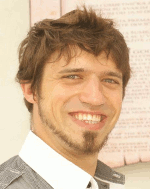 |
|
Biography
Florian Rudolf, born in Austria 1984, studied technical mathematics at the Technische Universität Wien. 2012 he received the degree of Diplomingenieur and started working on his doctoral degree on the Institute for Microelectronics. His scientific interests are geometry, computer graphics, and programming.
Symmetry-Aware 3D Volumetric Mesh Generation
Symmetric objects have the powerful property, that they can be reconstructed from a smaller piece of the overall object using rigid transformations. We investigated how a mesh generation algorithm can take advantage of this property to boost performance while producing meshes that preserve those symmetries, hence maintaining expected symmetrical invariants in simulations of symmetric processes.
Our work is motivated by devices and components used in microelectronic simulation, where complex geometries, especially very thin but wide layers, are common. To tackle this issue, we developed a mesh generation pipeline (visualized in Fig. 1) that generates a mesh of an object with rotational symmetries.
First, a symmetry detection algorithm is used to identify all rotational symmetries of the object. Then, the highest rotational symmetry order is selected and a slice, with a spanning angle equal to the angle of the rotational symmetry, is extracted from the object.
To avoid problems with interface compatibility between two neighboring slice meshes, a surface mesh of the slice is generated. This slice surface mesh is then used by a mesh generation algorithm to create a volumetric mesh while preserving the surface elements. Finally, the full mesh is obtained by rotated copies of the slice mesh.
To evaluate the performance and the element quality of our approach, benchmarks have been performed utilizing the free open source meshing framework ViennaMesh. The objects used for benchmarking have been motivated by through-silicon via (TSV) structures (shown in Figure 2), which are components for connecting silicon dies in an integrated circuit.
Performance benchmark results for synthetic TSV-like objects are presented in Figure 3. Generating quality mesh elements in thin layers is time-consuming, hence the pipeline overhead is much less significant and speedups by a factor of 3 to 10, in some cases up to 50, can be observed. Benchmarks using a practical TSV with a rotational symmetry order of 24 and 6 layers, with an even smaller thickness-to-length-ratio compared to the synthetic TSV-like object, yielded a speedup by a factor of 22.

Fig. 1: The symmetry-aware mesh generation pipeline.

Fig. 2: A cut of a through-silicon via (TSV) structure.

Fig. 3: Performance benchmarks for synthetic TSV-like objects.



